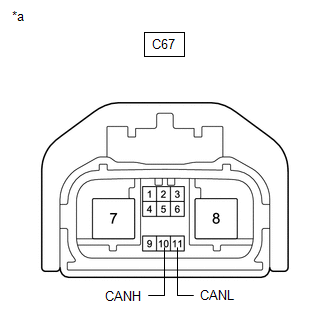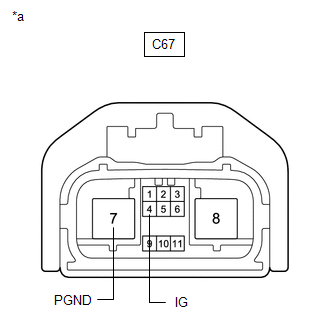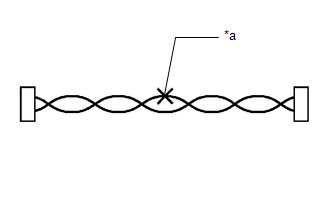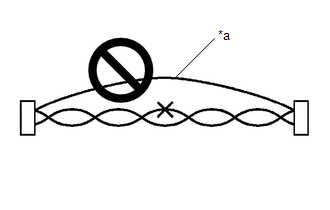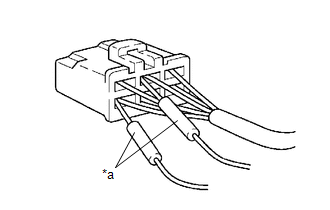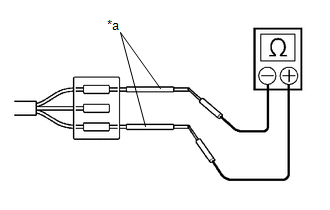|
Symptom | Suspected Area |
Link |
| Either of the following is met:
- Communication stop for "Hybrid Vehicle Control" is indicated on the "Communication Bus Check" screen of the Techstream.
- Communication stop history for "Hybrid Vehicle Control" is indicated on
the "Communication Bus Check (Detail)" screen of the Techstream. (The
Lost Communication Time value for "Hybrid Vehicle Control" is 6 or
more.)
| Hybrid Vehicle Control ECU Communication Stop Mode |
 |
|
Either of the following is met:
- Communication stop for "Skid Control (ABS/VSC/TRAC)" is indicated on the "Communication Bus Check" screen of the Techstream.
- Communication stop history for "Skid Control (ABS/VSC/TRAC)" is
indicated on the "Communication Bus Check (Detail)" screen of the
Techstream. (The Lost Communication Time value for "Skid Control
(ABS/VSC/TRAC)" is 6 or more.)
| Skid Control ECU Communication Stop Mode |
 |
|
Either of the following is met:
- Communication stop for "Clearance Warning (Intuitive Parking Assist)" is
indicated on the "Communication Bus Check" screen of the Techstream.
- Communication stop history for "Clearance Warning (Intuitive Parking
Assist)" is indicated on the "Communication Bus Check (Detail)" screen
of the Techstream. (The Lost Communication Time value for "Clearance
Warning (Intuitive Parking Assist)" is 6 or more.)
| Clearance Warning ECU Communication Stop Mode |
 |
|
Either of the following is met:
- Communication stop for "Air Conditioning Amplifier" is indicated on the "Communication Bus Check" screen of the Techstream.
- Communication stop history for "Air Conditioning Amplifier" is indicated
on the "Communication Bus Check (Detail)" screen of the Techstream.
(The Lost Communication Time value for "Air Conditioning Amplifier" is 6
or more.)
| Air Conditioning Amplifier Communication Stop Mode |
 |
|
Either of the following is met:
- Communication stop for "Power Steering (EPS)" is indicated on the "Communication Bus Check" screen of the Techstream.
- Communication stop history for "Power Steering (EPS)" is indicated on
the "Communication Bus Check (Detail)" screen of the Techstream. (The
Lost Communication Time value for "Power Steering (EPS)" is 6 or more.)
| Power Steering ECU Communication Stop Mode |
 |
|
Either of the following is met:
- Communication stop for "Spiral cable (Steering Angle Sensor)" is
indicated on the "Communication Bus Check" screen of the Techstream.
- Communication stop history for "Spiral cable (Steering Angle Sensor)" is
indicated on the "Communication Bus Check (Detail)" screen of the
Techstream. (The Lost Communication Time value for "Spiral cable
(Steering Angle Sensor)" is 6 or more.)
| Steering Angle Sensor Communication Stop Mode |
 |
|
Either of the following is met:
- Communication stop for "ECM (Engine)" is indicated on the "Communication Bus Check" screen of the Techstream.
- Communication stop history for "ECM (Engine)" is indicated on the
"Communication Bus Check (Detail)" screen of the Techstream. (The Lost
Communication Time value for "ECM (Engine)" is 6 or more.)
| ECM Communication Stop Mode |
 |
|
Either of the following is met:
- Communication stop for "Main Body" is indicated on the "Communication Bus Check" screen of the Techstream.
- Communication stop history for "Main Body" is indicated on the
"Communication Bus Check (Detail)" screen of the Techstream. (The Lost
Communication Time value for "Main Body" is 6 or more.)
| Main Body ECU Communication Stop Mode |
 |
|
Either of the following is met:
- Communication stop for "Combination Meter" is indicated on the "Communication Bus Check" screen of the Techstream.
- Communication stop history for "Combination Meter" is indicated on the
"Communication Bus Check (Detail)" screen of the Techstream. (The Lost
Communication Time value for "Combination Meter" is 6 or more.)
| Combination Meter ECU Communication Stop Mode |
 |
|
Either of the following is met:
- Communication stop for "Certification (Smart)" is indicated on the "Communication Bus Check" screen of the Techstream.
- Communication stop history for "Certification (Smart)" is indicated on
the "Communication Bus Check (Detail)" screen of the Techstream. (The
Lost Communication Time value for "Certification (Smart)" is 6 or more.)
| Certification ECU Communication Stop Mode |
 |
|
Either of the following is met:
- Communication stop for "Airbag" is indicated on the "Communication Bus Check" screen of the Techstream.
- Communication stop history for "Airbag" is indicated on the
"Communication Bus Check (Detail)" screen of the Techstream. (The Lost
Communication Time value for "Airbag" is 6 or more.)
| Center Airbag Sensor Communication Stop Mode |
 |
|
Either of the following is met:
- Communication stop for "HL AutoLeveling/AFS/AHS (Sub)" is indicated on the "Communication Bus Check" screen of the Techstream.
- Communication stop history for "HL AutoLeveling/AFS/AHS (Sub)" is
indicated on the "Communication Bus Check (Detail)" screen of the
Techstream. (The Lost Communication Time value for "HL
AutoLeveling/AFS/AHS (Sub)" is 6 or more.)
| Headlight ECU RH Communication Stop Mode |
 |
|
Either of the following is met:
- Communication stop for "HL AutoLeveling/AFS/AHS" is indicated on the "Communication Bus Check" screen of the Techstream.
- Communication stop history for "HL AutoLeveling/AFS/AHS" is indicated on
the "Communication Bus Check (Detail)" screen of the Techstream. (The
Lost Communication Time value for "HL AutoLeveling/AFS/AHS" is 6 or
more.)
| Headlight ECU LH Communication Stop Mode |
 |
|
Either of the following is met:
- Communication stop for "Electric Parking Brake" is indicated on the "Communication Bus Check" screen of the Techstream.
- Communication stop history for "Electric Parking Brake" is indicated on
the "Communication Bus Check (Detail)" screen of the Techstream. (The
Lost Communication Time value for "Electric Parking Brake" is 6 or
more.)
| Electric Parking Brake ECU Communication Stop Mode |
 |
|
Either of the following is met:
- Communication stop for "Display and Navigation (AVN)" is indicated on the "Communication Bus Check" screen of the Techstream.
- Communication stop history for "Display and Navigation (AVN)" is
indicated on the "Communication Bus Check (Detail)" screen of the
Techstream. (The Lost Communication Time value for "Display and
Navigation (AVN)" is 6 or more.)
| Radio Receiver Assembly Communication Stop Mode |
 |
|
Either of the following is met:
- Communication stop for "Blind Spot Monitor Master" is indicated on the "Communication Bus Check" screen of the Techstream.
- Communication stop history for "Blind Spot Monitor Master" is indicated
on the "Communication Bus Check (Detail)" screen of the Techstream. (The
Lost Communication Time value for "Blind Spot Monitor Master" is 6 or
more.)
| Blind Spot Monitor Sensor Communication Stop Mode |
 |
|
Either of the following is met:
- Communication stop for "Panoramic View Monitor / Circumference
Monitoring Camera Control Module" is indicated on the "Communication Bus
Check" screen of the Techstream.
- Communication stop history for "Panoramic View Monitor / Circumference
Monitoring Camera Control Module" is indicated on the "Communication Bus
Check (Detail)" screen of the Techstream. (The Lost Communication Time
value for "Panoramic View Monitor / Circumference Monitoring Camera
Control Module" is 6 or more.)
| Parking Assist ECU Communication Stop Mode |
 |
|
Either of the following is met:
- Communication stop for "Multiplex Tilt and Telescopic" is indicated on the "Communication Bus Check" screen of the Techstream.
- Communication stop history for "Multiplex Tilt and Telescopic" is
indicated on the "Communication Bus Check (Detail)" screen of the
Techstream. (The Lost Communication Time value for "Multiplex Tilt and
Telescopic" is 6 or more.)
| Tilt and Telescopic ECU Communication Stop Mode |
 |
|
Either of the following is met:
- Communication stop for "DCM" is indicated on the "Communication Bus Check" screen of the Techstream.
- Communication stop history for "DCM" is indicated on the "Communication
Bus Check (Detail)" screen of the Techstream. (The Lost Communication
Time value for "DCM" is 6 or more.)
| DCM Communication Stop Mode |
 |
|
Either of the following is met:
- Communication stop for "D-Seat" is indicated on the "Communication Bus Check" screen of the Techstream.
- Communication stop history for "D-Seat" is indicated on the
"Communication Bus Check (Detail)" screen of the Techstream. (The Lost
Communication Time value for "D-Seat" is 6 or more.)
| Driver Seat Control ECU Communication Stop Mode |
 |
|
Either of the following is met:
- Communication stop for "Front Door LH/L-Mirror (FL-Door/L-Mirror)" is
indicated on the "Communication Bus Check" screen of the Techstream.
- Communication stop history for "Front Door LH/L-Mirror
(FL-Door/L-Mirror)" is indicated on the "Communication Bus Check
(Detail)" screen of the Techstream. (The Lost Communication Time value
for "Front Door LH/L-Mirror (FL-Door/L-Mirror)" is 6 or more.)
| Door Mirror ECU LH Communication Stop Mode |
 |
|
Either of the following is met:
- Communication stop for "Front Door RH/R-Mirror (FR-Door/R-Mirror)" is
indicated on the "Communication Bus Check" screen of the Techstream.
- Communication stop history for "Front Door RH/R-Mirror
(FR-Door/R-Mirror)" is indicated on the "Communication Bus Check
(Detail)" screen of the Techstream. (The Lost Communication Time value
for "Front Door RH/R-Mirror (FR-Door/R-Mirror)" is 6 or more.)
| Door Mirror ECU RH Communication Stop Mode |
 |
|
Either of the following is met:
- Communication stop for "Driving Support (CruiseControl-ACC)" is
indicated on the "Communication Bus Check" screen of the Techstream.
- Communication stop history for "Driving Support (CruiseControl-ACC)" is
indicated on the "Communication Bus Check (Detail)" screen of the
Techstream. (The Lost Communication Time value for "Driving Support
(CruiseControl-ACC)" is 6 or more.)
| Driving Support ECU Communication Stop Mode |
 |
|
Either of the following is met:
- Communication stop for "Head Up Display" is indicated on the "Communication Bus Check" screen of the Techstream.
- Communication stop history for "Head Up Display" is indicated on the
"Communication Bus Check (Detail)" screen of the Techstream. (The Lost
Communication Time value for "Head Up Display" is 6 or more.)
| Headup Display Communication Stop Mode |
 |
|
Either of the following is met:
- Communication stop for "Front Radar" is indicated on the "Communication Bus Check" screen of the Techstream.
- Communication stop history for "Front Radar" is indicated on the
"Communication Bus Check (Detail)" screen of the Techstream. (The Lost
Communication Time value for "Front Radar" is 6 or more.)
| Millimeter Wave Radar Sensor Communication Stop Mode |
 |
|
Either of the following is met:
- Communication stop for "Motor Generator" is indicated on the "Communication Bus Check" screen of the Techstream.
- Communication stop history for "Motor Generator" is indicated on the
"Communication Bus Check (Detail)" screen of the Techstream. (The Lost
Communication Time value for "Motor Generator" is 6 or more.)
| Motor Generator Control ECU Communication Stop Mode |
 |
|
Either of the following is met:
- Communication stop for "Parking Assist Monitor System / Rear Camera" is
indicated on the "Communication Bus Check" screen of the Techstream.
- Communication stop history for "Parking Assist Monitor System / Rear
Camera" is indicated on the "Communication Bus Check (Detail)" screen of
the Techstream. (The Lost Communication Time value for "Parking Assist
Monitor System / Rear Camera" is 6 or more.)
| Rear Television Camera Communication Stop Mode |
 |
|
Either of the following is met:
- Communication stop for "Occupant Detection" is indicated on the "Communication Bus Check" screen of the Techstream.
- Communication stop history for "Occupant Detection" is indicated on the
"Communication Bus Check (Detail)" screen of the Techstream. (The Lost
Communication Time value for "Occupant Detection" is 6 or more.)
| Restraints Occupant Classification System Module Communication Stop Mode |
 |
|
Either of the following is met:
- Communication stop for "Grill Shutter" is indicated on the "Communication Bus Check" screen of the Techstream.
- Communication stop history for "Grill Shutter" is indicated on the
"Communication Bus Check (Detail)" screen of the Techstream. (The Lost
Communication Time value for "Grill Shutter" is 6 or more.)
| Grille Shutter Communication Stop Mode |
 |
|
Either of the following is met:
- Communication stop for "Front Camera Module" is indicated on the "Communication Bus Check" screen of the Techstream.
- Communication stop history for "Front Camera Module" is indicated on the
"Communication Bus Check (Detail)" screen of the Techstream. (The Lost
Communication Time value for "Front Camera Module" is 6 or more.)
| Front Camera Module Communication Stop Mode |
 |
|
Either of the following is met:
- Communication stop for "Tire Pressure" is indicated on the "Communication Bus Check" screen of the Techstream.
- Communication stop history for "Tire Pressure" is indicated on the
"Communication Bus Check (Detail)" screen of the Techstream. (The Lost
Communication Time value for "Tire Pressure" is 6 or more.)
| Tire Pressure Monitor ECU Communication Stop Mode |
 |







